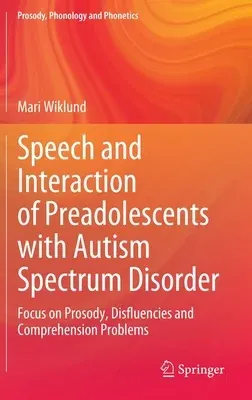Preface1. Introduction1.1. Background1.2. Topics treated in the book1.3.
Data1.4. Methods2. Prosody2.1. Overview of previous research on the
prosody of persons with ASD2.2. Prosodic characteristics of
preadolescent boys with ASD2.3. Perception of atypicality by
neurotypical listeners2.4. The role of prosodic features in the creation
of comprehension problems2.5. Conclusion3. Disfluencies3.1. Overview of
previous research on disfluencies in the speech of persons with ASD3.2.
Disfluencies in the speech of preadolescent boys with and without
ASD3.3. The role of disfluencies in the creation of comprehension
problems3.4. Conclusion4. Comprehension problems4.1. Overview of
previous research on conversational repairs in the interaction of
persons with ASD4.2. Causes of comprehension problems in group therapy
sessions involving preadolescent boys with ASD4.2.1. Overly literal
interpretation of speech4.2.2. Topical discontinuities4.2.3. Non-verbal
features associated with trouble-source turns: the role of eye
contact4.2.4. Other causes of comprehension problems4.3. Conclusion5.
Gaze behavior5.1. Overview of previous studies on the role of gaze in
interaction from a conversation analytic point of view 5.2. Overview of
previous studies on gaze-related features in the interaction of persons
with ASD.5.3. Three main patterns used for avoiding eye contact in group
therapy sessions involving preadolescents boys with ASD5.3.1. Fixing
one's gaze straight ahead5.3.2. Letting one's gaze wander around5.3.3.
Looking at one's own hands when speaking5.4. General remarks on the gaze
behaviour of preadolescents boys with ASD5.5. Conclusion
6. Therapists' response strategies and teaching orientations 6.1.
Therapists' response strategies in group therapy sessions involving
preadolescent boys with ASD6.1.1. Introduction6.1.2. Five most common
response strategies6.1.2.1. Approval 6.1.2.2. Comment on the contents of
a turn / turns 6.1.2.3. Question addressed to the whole group 6.1.2.4.
Question concerning the contents of a turn / turns 6.1.2.5. Rephrasing
the contents of a turn / turns 6.2. Therapists' teaching orientations in
group therapy sessions involving preadolescent boys with ASD6.2.1.
Introduction6.2.2. Implicit teaching orientation6.2.3. Explicit teaching
orientation6.2.4. Prosodic problems: beyond teaching orientations?6.3.
Conclusion7. ConclusionBibliography List of transcription
conventionsIndex of key words

